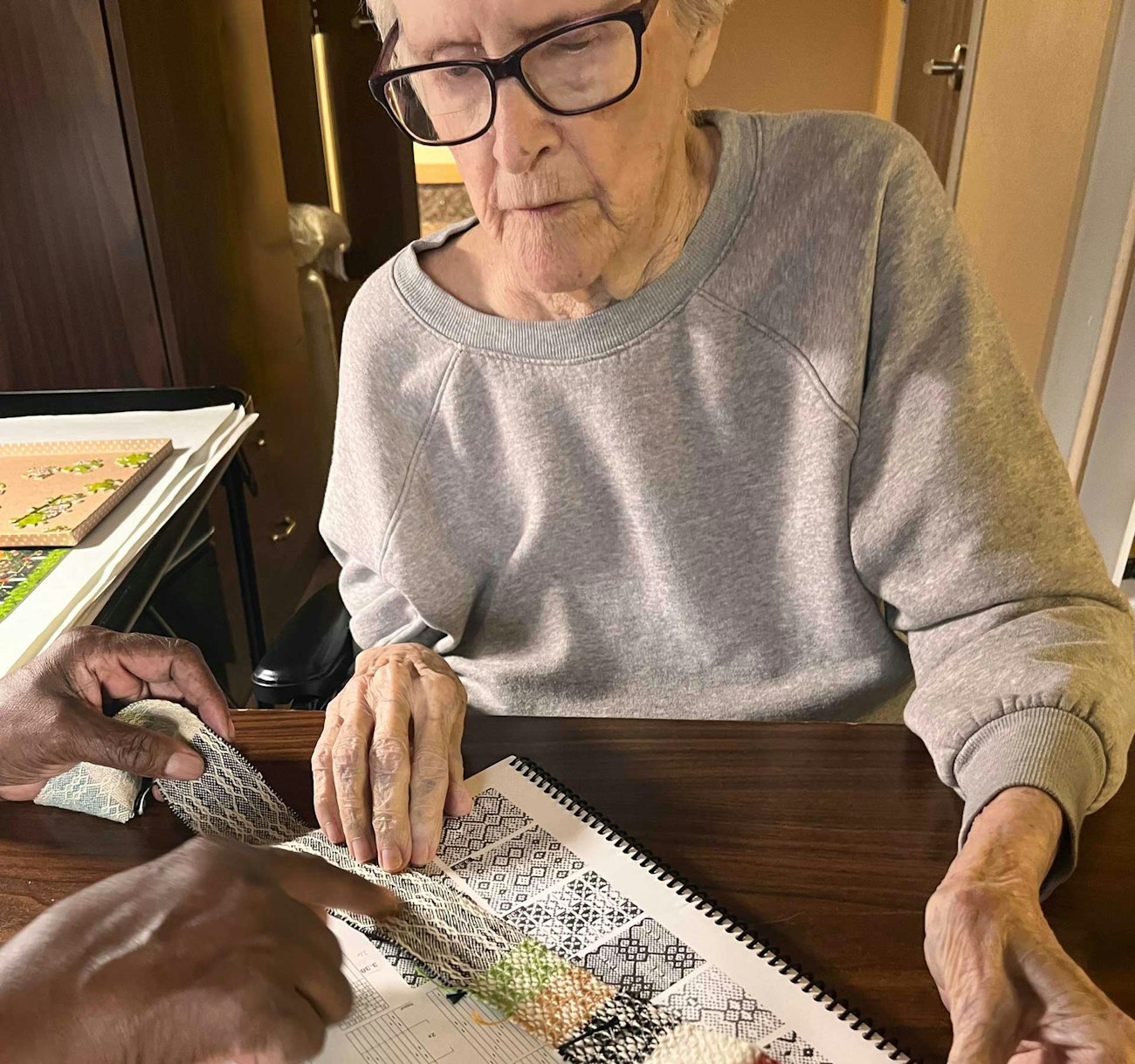An aging body and mind can have a broad impact on our lives—what we create, how our bodies perform, and the choices we make about weaving. We are occupational therapists as well as vintage weavers, which gives us insights into the physical challenges that aging presents to weavers, as well as tactics for managing those difficulties.
Meet Faye
Faye is a 76-year-old weaver. For years, she balanced family life, including her spouse, children, and grandchildren, with work, time spent weaving, and guild activities—until COVID-19 hit. Faye’s husband died, she retired, her grandchildren were in college, and her guild disbanded. As the world recovered, she felt uncertain about returning to her routine, especially driving. Faye’s doctor confirmed that her hearing was not as crisp as it once was. She continued to weave, but her work had more errors and it simply wasn’t as much fun when she couldn’t strut her stuff for guild buddies. Loneliness was her new norm, and she missed her old life.
Isolation, loneliness, anxiety, and depression can be the result of life changes like the ones Faye experienced. Here’s what we learned about those issues in our search of the literature.
- The Centers for Disease Control (CDC) notes that isolation, loneliness, anxiety, and depression are threats to our mental health and not a normal part of aging, even though 1 in 10 seniors are affected. Depression isn’t just a sad or bad mood; it can be low energy, agitation, slowed thinking, confusion, or feeling hopeless. The CDC recommends social and activity programs to beat depression.
Weaving is a meaningful way to get active. If you want company while no one is around, consider using a speakerphone to chat with a friend as you weave. Our friend Mary recommends, “Take a class periodically, a real human-to-human class, not an online class, where you will not only learn something but also have conversations on topics other than weaving.” - Life satisfaction is also important for well-being. Doing something satisfying—such as designing a new project, making progress on a weaving project, enjoying the rhythm and sounds of the loom, or finishing a project—can lighten your mood and have a positive impact on your health.
- Most of all, don’t hesitate to seek out help from a healthcare provider rather than trying to tough it out. Depression is a medical condition and often treatable. See the resources in “Want to Learn More?” to help you get started on a path to mental health. - Older adults can do more than many give them credit for, including working while providing wisdom and guidance for younger people. Consider mentoring a younger or newer weaver for your mutual benefit.
- Hearing loss leads to social isolation. Adjustments to the environment or using technology such as hearing aids or amplifiers can make a difference. It might be time to get that hearing checked, especially if you envision attending future guild meetings.
- Older adults have a range of life experiences and time to devote to their communities. Don’t hesitate to try something new—like an unfamiliar pattern, fiber, or way of pacing yourself. Our friend Diane picked up small-loom weaving after retirement.
“I had more leisure time and decided to try weaving again after 35 years. I found it rewarding to have the familiarity of weaving but learn new tools and techniques,” she said. In two years, Diane has collected several types of small looms to add variety to her leisure pursuits.
Ways to Beat the Blues
Along with death and taxes, we have little control over some things—COVID-19, for example.
But there are steps we can take to improve our mood—we can modify what we eat, investigate our hearing health, move through rough patches with a little help from our friends, and use technology to our benefit.
Help Your Body
Many foods promote health and reduce anxiety. If you want to get your weaving energy back, it’s a good idea to eat and drink things that make you feel better. It’s probably no surprise that what some call squirrel food (seeds, nuts, berries, and green vegetables) plus water are great choices. You might be extra happy to hear that regularly adding dark chocolate, green tea, almonds, and blueberries to your meals is especially good for managing anxiety.

Add dark chocolate and nuts to your diet. The chocolate in particular is good for managing anxiety . . . but you already knew that! Photo by Amirali Mirhashemian on Unsplash
Amp It Up
About one in four people over age 65 have hearing difficulties. Hearing loss causes declines in community participation, including guild meetings and other social functions weavers enjoy. To offset this, your first consideration should be about environment. Advocate for meetings in small rather than large rooms—a classroom is a better choice than a fellowship hall. If the room is well-lit, you‘ll also have an easier time reading gestures and lips.
If you want an assist from technology, you can consider over-the-counter hearing amplifiers. These aids, designed for mild hearing losses, amplify all sounds. Depending on your personal loss, they may help you hear better—or they can make matters worse (even including damaging your hearing). Individuals with significant hearing loss should consult a hearing specialist.
A second option for meetings is a venue-based assistive listening system such as those used in churches or concert halls. They filter out background noise and deliver sound directly to your ears via earbuds.
A third option is prescription hearing aids. Hearing aids clarify speech and filter out background noise. They can be tuned to accommodate the shape and noise level of rooms, and Bluetooth technology can link them to a clip-on microphone, microphone station, or smartphone. Hearing aid specialists make custom adjustments for each user, so be sure to tell them about your specific hearing needs. For example, when Tina is teaching, her hearing aids are set to classroom mode.
Make Friends with the Internet
If you aren’t quite ready to return to guild meetings, you can venture into internet weaving. We all gripe about COVID-19, but it provided the unexpected benefit of creating user-friendly and fun online courses and groups.
Tina met a weaver in her 80s who takes monthly Zoom classes as well as self-paced lessons. Her teacher mails her bundles of supplies and patterns, and offers studio hours for online troubleshooting—from Norway!
Want to join a group that meets in real time? Because everyone logs on at once, this feels like a traditional classroom, with students participating in discussions and listening to lectures. Our friend Mary and her guild have an interesting way to mix Zoom with real time. She told us, “To learn about Bateman weaves, we had an expert Zoom lecture us, and then each of us picked a Bateman draft to weave for everyone.”
Want an asynchronous (on-demand) program? These allows you to take classes when you want, and instructors worldwide can participate. Some examples of online weaving classes include those from Handwoven and Long Thread Media at learn.longthreadmedia.com, School of SweetGeorgia at schoolofsweetgeorgia.com, and School of Weaving at janestaffordtextiles.com.
When considering specific classes, ask yourself:
- Does the site have good sound and visual quality?
- What’s the charge for taking classes and downloading materials?
- Does your device support the platform used (such as Zoom or Google Meet)?
Try Some Apps
If you feel anxious, try a meditation app to prepare for weaving or guild meetings. With a calm mind and body you will relax, make fewer errors, and deal with challenges better. And calming music can help you establish a gentle yet productive weaving pace. Here are apps we enjoy:
- Buddhify (buddhify.com): Nonconformists will appreciate that this app doesn’t tell you what to do; it offers 200-plus meditations.
- Calm (calm.com): This app offers meditations and music from mindfulness experts.
- Ten Percent Happier (tenpercent.com): This app gets to know you. It offers guided meditations, talks, daily features, and uplifting stories to relieve stress.
Remember Faye?
Faye contacted a grandson who walked her through online weaving groups until she found an asynchronous program. As she learned, she could turn up the volume on her computer to what worked for her. He also helped her pick a calming app she enjoyed. When she felt comfortable with online weaving classes and app meditations, Faye planned a visit to a guild meeting. She learned to use Uber for transportation, and found some friends who had also returned to the meetings. Three of them agreed to try hearing aids, which made it easier to participate in discussions and workshops. Together, Faye and her friends are happier, more energetic, and looking forward to many years of weaving together.

At 95 years old, Tina’s mother-in-law, Lillian Selvaggi (now deceased), offered her opinions about weave structure, color, and fiber. Photo by Tina Fletcher
Together, CYNTHIA EVETTS and TINA FLETCHER have 83 years of weaving experience, 78 years of occupational therapy practice, 47 years in higher education, and 19 years of friendship and shockingly similar interests. They are Vintage with a capital V.

